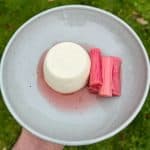Greek Yogurt Panna Cotta With Poached Rhubarb
We're pairing a creamy Greek yoghurt panna cotta with some lightly poached forced rhubarb. The tangy panna cotta & sweet rhubarb work perfectly together!
Servings: 4 People
Equipment
- 4 150ml Pudding Moulds
- Medium Saucepan
- Sieve
- 2 Mixing Bowls (1 Large & 1 Medium)
- Baking Tray
Ingredients
Greek Yogurt Panna Cottas
- 300 g Double Cream
- 150 g Whole Milk
- 75 g Caster Sugar
- ½ Vanilla Pod
- 3 Gelatine Leaves
- 150 g Greek Yogurt
Poached Rhubarb
- 400 g Forced Rhubarb (See Notes)
- 650 g Water
- 150 g Caster Sugar
- 1 Large Orange
- 1 Star Anise
- ½ Cinnamon Stick
- ½ Vanilla Pod
Instructions
Greek Yogurt Panna Cottas
- First, place the gelatine into a container of cold water & leave to soak.Adding the sheets of gelatine into the water one at a time helps them soak better.
- Next, place the cream, milk & sugar into a saucepan. Scrape the seeds out of the vanilla pod & add both the seeds & pod to the milk & cream.
- Place the pan over a low heat & allow to warm gently, stirring occasionally. Once steaming (don’t let it boil!) remove the pan from the heat.
- Squeeze as much water as you can from the soaked gelatine then add to the cream & stir until dissolved. Add in the Greek yogurt, whisk to combine then pass the mix into a bowl through a sieve.
- Fill a larger, separate bowl up with ice & water then place the bowl containing the cream into the bowl of water. Stir the panna cotta mix regularly until it has cooled down & has started to thicken. This will take around 20 minutes.Allowing the panna cotta mix to cool like this holds the vanilla seeds in suspension, preventing them from sinking.
- Transfer the panna cotta mix to a jug then pour into the moulds. Place in the fridge & leave to set. This will take a minimum of 4 hours.
Poached Rhubarb
- Lightly trim the ends off the rhubarb then cut each stalk into 6 cm long pieces. Set these aside for now.
- Next, add the water & sugar into a medium saucepan. Cut the zest from the orange then add into the pan along with 75 grams of the juice, the star anise & cinnamon stick. Scrape the seeds out of the vanilla pod & add both the pod & seeds into the pan as well.Trim as much of the white pith from the zest as possible as this tastes bitter.
- Set the pan over a low heat & cook, stirring regularly until the sugar has dissolved. This will take 3-4 minutes.
- Next, add the rhubarb into the pan then poach gently, until just tender. The rhubarb should be soft but still hold its' shape.The rhubarb will only take around 5 minutes to cook, depending on the thickness of the stalks. If some of your rhubarb is thinner, poach it separately to avoid over cooking.
- Once your rhubarb is cooked, carefully transfer it to a plate & set to one side.
- Next, set the pan over a high heat, bring to the boil then cook the poaching liquid until it has reduced into a syrup. This will take around 5-10 minutes. Once ready, take the syrup off the heat & leave to cool slightly.
- Once cool, add the rhubarb into a container then pour the syrup over, through a sieve. Chill in the fridge until needed.
Plating Up
- Fill a medium sized bowl up with hot water.
- Dunk a mould into the hot water then take it straight out.Don’t fully submerge the pudding mould, we don’t want to get the panna cotta wet.
- Gently loosen the panna cotta’s top edge using your fingers then carefully turn out onto a plate/into a bowl. Repeat with the remaining panna cottas.If the panna cotta won’t come out, dunk the mould into the water a second time.
- Spoon over a generous amount of the rhubarb & syrup then serve.
Notes
1. Storage – Kept in the fridge, the panna cottas & rhubarb will keep for up to 3 days.
2. Gelatine – I use Dr Oetker platinum grade gelatine sheets but other brands will work as well.
3. Rhubarb - I used forced rhubarb for this recipe, which is why it's bright pink! If this isn't in season, regular rhubarb will work as well.
4. Vanilla – I’d recommend using a vanilla pod to flavour the cream. You only need half of one but you could also use a teaspoon of vanilla paste instead.
5. Warming The Cream – Don’t let the milk & cream boil as this will affect how the gelatine sets. It just needs to be steaming.
6. Cooling – Once the panna cotta mix has been made, it needs to be stirred regularly until cold before being poured into the moulds. This is how to stop the vanilla seeds from sinking.
7. Mould Size – This recipe makes 4 panna cottas using 150ml pudding moulds. You can use different size moulds to make more or less portions. Keep in mind that the setting time might vary.
